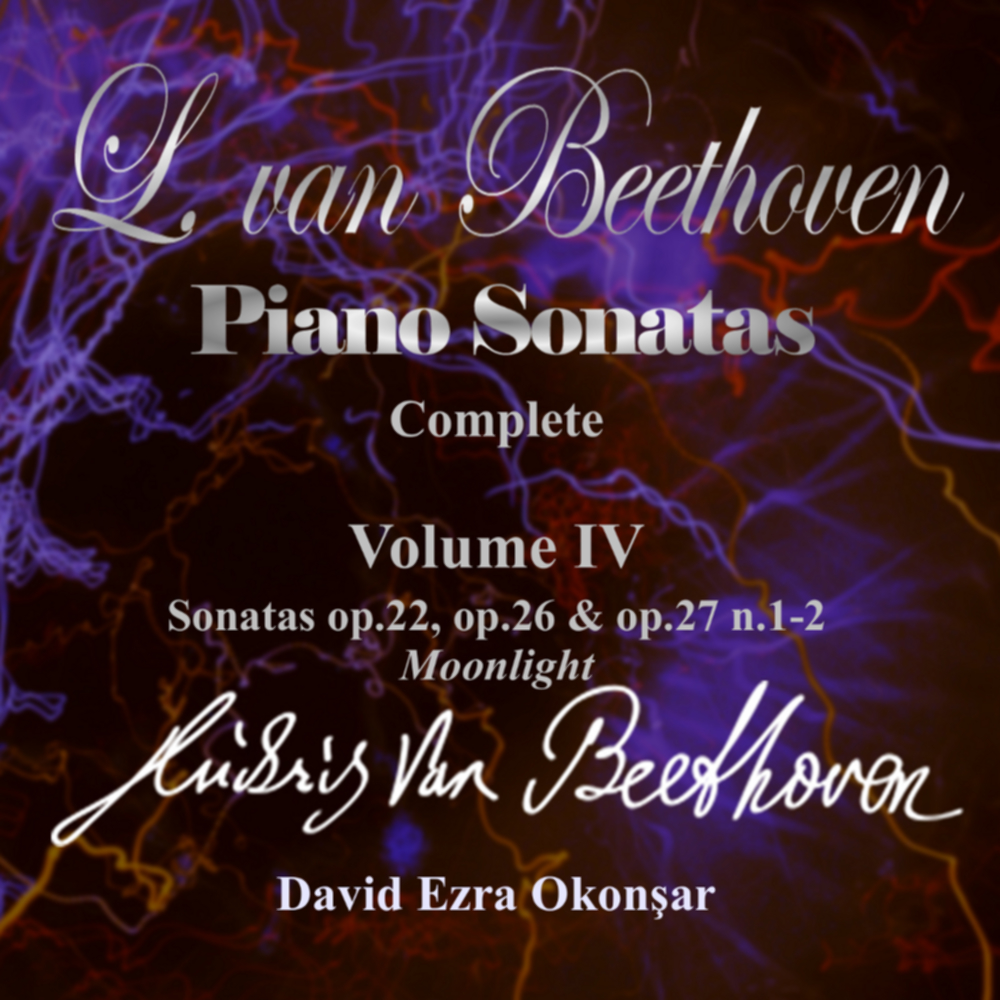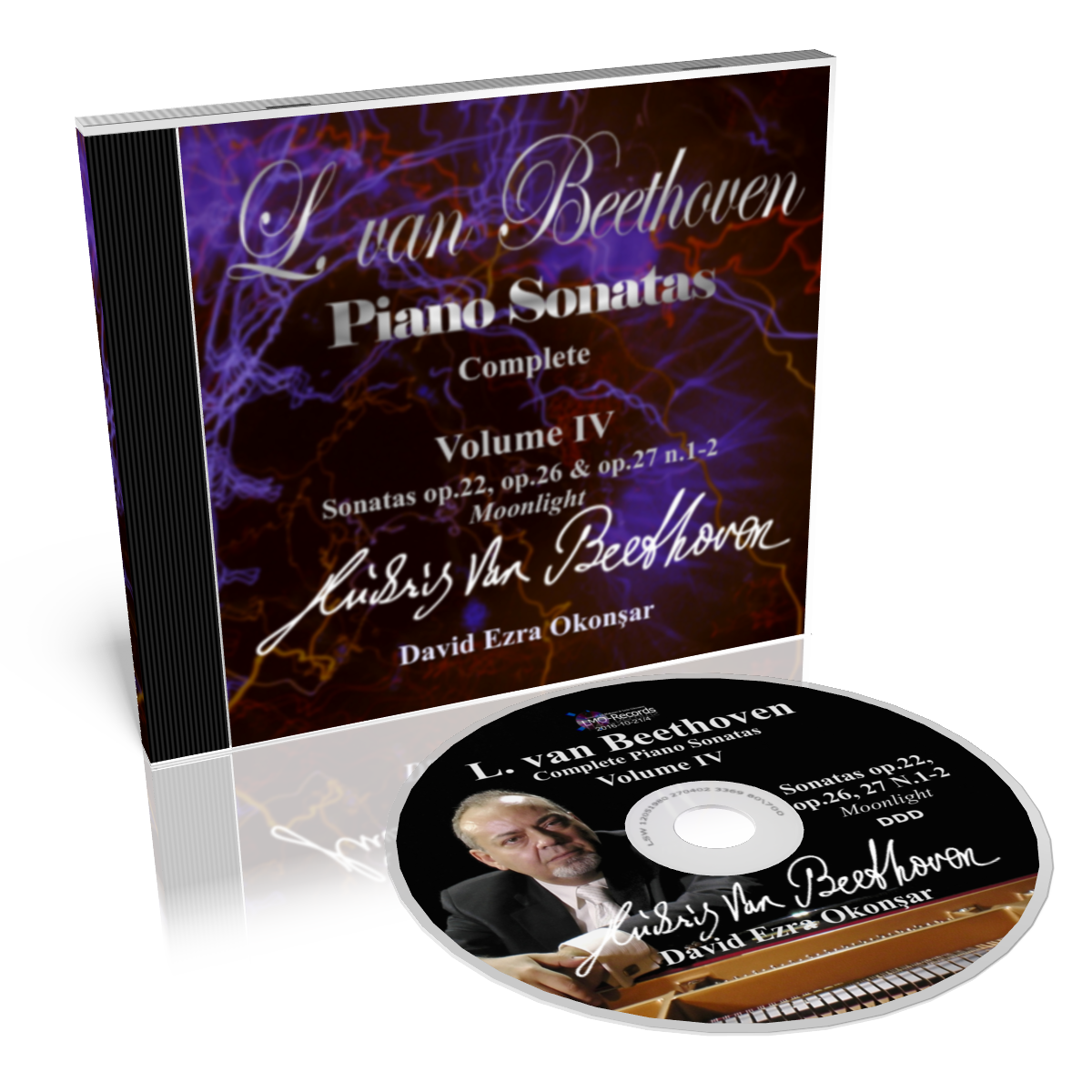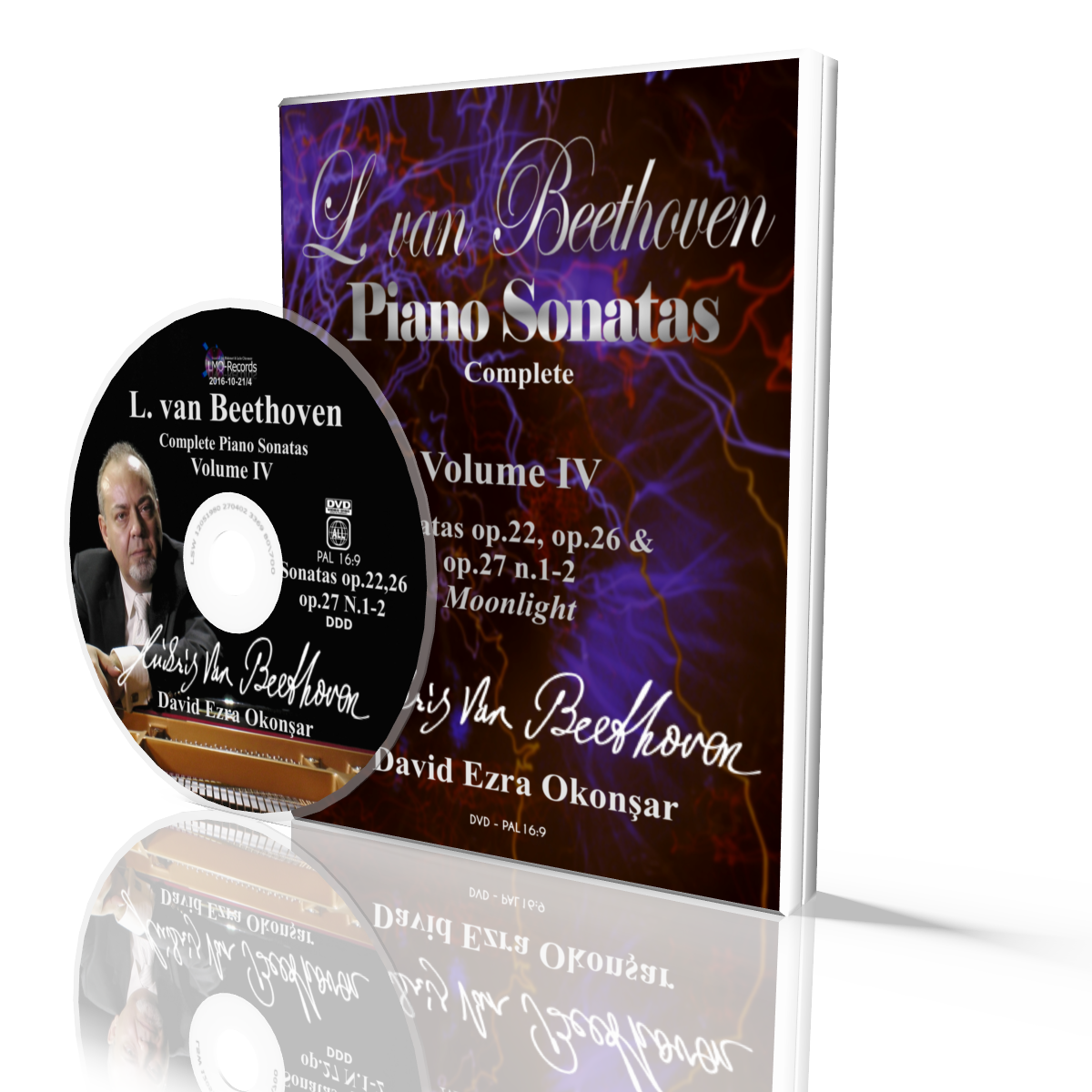
Piano Sonatas VOL. 4
opp.22, 26
op.27 N.1 & 2 Moonlight
Volume 4 of the series:
The Complete Piano Sonatas by Ludwig van Beethoven



|
The Volume IV of the complete Beethoven Piano Sonatas
series by David Ezra Okonsar featuring Sonatas N. 11, 12, 13 and 14
("Moonlight")
Sonata N.11 in B-flat major op.22"Grande sonate pour le pianoforte, dediee a M. le Comte de Browne, brigadier au service de Sa Majeste Imperiale de toute la Russie" is the complete title for this work composed from 1799 to 1800 and published in 1802 by Hoffmeister in Leipzig. This is also the publisher of the Symphony N.1 in C major which is composed around the same dates. It is probable that Beethoven did not drafted this piano sonata in such large dimensions, but re-worked and expanded it later before its publication. It is the largest work of the so-called "first-style" of Beethoven. Also is interesting to note that this form of a large sonata in four movements will reappear later in only a few more piano sonatas, among them the Sonata opus 28 and the "Hammerklavier" Sonata opus 106. Jorg Demus pointed that "this particular form of Sonata in four movements which was almost abandoned by Beethoven, will precisely become the shape of the romantic sonata as it is seen in the late works by Schubert, all sonatas by Schumann, Chopin and Brahms." Beethoven appears here in the historical continuity of Haydn and Mozart, but the extremely epic musical discourse of this opus is on another conception. "Particularly well-done" did say the composer about that sonata. Its main feature is nevertheless the pianistic "brio" and it may be seen as a definitive "adieu" to the Haydn-Mozart style. I. Allegro con brio The leaping musical "cell", animated with a four-notes long inner voice, embodies all the dynamic energy of the movement. Immediately appears right from the beginning of the first movement a rich and majestic grandeur. We often witness a sound like a piano part over an orchestral accompaniment. The entire movement has a subjugating and undefeatable power all through. II. Adagio In the warm and grandiose tonality of E-flat major, the one of the Sonata opus 7, a magnificent melody is deployed over soft repeated strings-section like chords, as if a solo clarinet part, of most intense poetry. The movement is in a sonata-form of its own. The second theme is with thirds, fourths and sixths with rich dissonances throughout. At the end of the exposition of this "mini-sonata-movement" a most intriguing modulation to G major creates an almost "Wagnerian" chromaticism. III. Tempo di menuetto Not really a Menuetto but "in the tempo of a Menuetto", this movement realizes an interesting amalgam between the Rococo style with the typical upbeat of three notes and many appoggiaturas, and the majestic mood of the Court dance. The "Trio", however is even less conventional. It is taken "forte" in G minor with running sixteenth notes through two octaves. The repeat, "da capo", of the Tempo di Menuetto creates then a feeling of a strong contrast as an "after-effect". IV. Rondo: Allegretto The Finale is an imposing final Rondo with a sure pianistic effect. The principal theme, in a fluid legato style, sometimes detache, is characteristic with its broken octaves at the right hand and parallel sixths at the left. The second theme, more restraint, is followed by a third one, extremely fluid and animated. A higher level of harmonic complexity is attained in the development, vast and somewhat contrapuntal in its writing, calling for a high level of virtuosity. This brings out the full expanded re-exposition of the second theme, this time fortissimo. The coda reminds the very first theme in pianissimo, but the Sonata ends fortissimo. Sonata N.12 in A-flat major op.26 Dedicated to the prince Karl von Lichnowsky, this Sonata was published in 1802 by Cappi in Vienna. The first drafts were penned in 1800 and the Sonata was probably finished during 1801. The title given by Beethoven to the third movement: "Marcia funebre sulla morte d'un Eroe" was already there in the drafts of 1800. This shows that the Funeral March has been prepared since the early conception of the work and was not inserted afterwards as it has been alleged sometimes. However the (final) Allegro was first put before the Funeral March and later the composer changed this to be the last movement. Many noted the analogies between this and the Funeral March of the Eroica Symphony, started at 1802 but finished two years later and the very famous one of Chopin, Sonata in B-flat minor. Chopin, himself played this Beethoven Sonata on some occasions. In all cases, this Sonata, the Eroica Symphony and the Chopin Sonata, it is interesting to note that the Scherzo is placed as a second movement, before the Funeral March and both Chopin and Beethoven Sonatas end with a fast Allegro (or Presto, in the case of Chopin). The "Allgemeine Musikalische Zeitung", in 1802 wrote: "May be some passages are over-worked (i.e. too sophisticated). But this is a piece with a grandiose harmony, dark and beautiful, because there, everything which is elaboration and art is required for the expression." I. Andante con Variazioni Breaking with the traditional "Sonata-Allegro" form, Beethoven opens the piece with a series of variations. Andre Boucourechliev noted that in those variations Beethoven breaks with the traditional, classical, "ornamental" variations where a single melody (theme) is maintained during the set and embellished throughout. This set, notes Boucourechliev, is the precursor of these big, magnificent variation sets which are to come later. The theme is a calm and deep melody presented with both hands at unison octaves. Very close to the Impromptu op.142 n.2 by Schubert, this melody, notes Paul Badura-Skoda, maintains the spirit of a Lied all through the set. The first variation is a deployment of the harmonic structure and the second is a splendid animation on syncopes at both hands. The third variation in A-Flat minor prefigures the Funeral March by its lugubrious setting. A kind of Scherzo is the idea of the fourth variation, presented with subtle rhythmic and metric finesse, almost pianissimo all through. The last number re-states the theme with sublime figurations and embellishments at the right hand playing both the melody and the figurations over fluid left hand arpeggios. The Coda, calm and serene, closes the first movement "senza sordino" that is with pedale. All variations are in the 3/8 time signature of the theme. II. Scherzo, Allegro molto Brisk and leaping, the Scherzo is built on a simple raising scale motive. Developed by the use of diatonic thirds, this simple scale fragment is loaded with awesome energy. The Trio is a kind of "berceuse" with legato octaves. III. Marcia funebre (Maestoso) This Funeral March has been played at the composer's funerals. This is a sublime Funeral march and its orchestral scoring has been transcribed, easily, to walking bands and all kinds of orchestral formations. The lugubrious main melody on A-flat minor articulated on one single note (E-flat) modulates over a cycle of sometimes very far fetched keys using enharmonic relations. Therefore we get C-flat major, B minor and major, D major, E-flat minor and so on. The central part is even more orchestral in its writing. Military drums with tremolos, brass instruments sforzato chords depict clearly war scenes and heroism. The Coda which concludes the movement is harmonized with an incredible chromaticism and seems to float between minor and major before settling down in a calm and serene A flat major which achieves the epic story. III. Allegro A very elegant theme made of broken chords, somewhat in the style of an Etude by Cramer brings the listener out of the dark atmosphere of the Funeral March. Following such an epic, Legend-like, grandiose and sad Marcia Funebre, this last movement may seem somewhat casual. It sounds to me as if life is getting back to its "normal" course. The movement is built without any variations of the theme, as a simple and straightforward Rondo. Yet the ending still reminds the minor sound colors of the Funeral March by the apparitions of G-flat and F-flat notes within the prevailing A-flat major and its conclusion is by a straight fall into the low keys. Sonata N.13 in E-flat major op.27 n.1 "Quasi una Fantasia" Composed in 1801 and 1802, published the same year in Vienna, both Sonatas opus 27 were dedicated to the Princesse Joséphine von Liechtenstein and share a common subtitle: "Quasi una fantasia". The dedication of the second number of the series, the famous "Moonlight", will be later changed to the Countess Giulietta Guicciardi, whom the composer loved with great passion. "Fantasieren" in this context, in German means "as an improvisation". That was, in the years 1800, quite a shocking statement on the front page of a published musical work. The word "quasi" (like) signifies that the performer must make the illusion of an improvisation. All movements of those sonatas are interconnected and the then common practice of playing one movement of a Sonata separately is not allowed clearly by the composer. A look into the manuscript surprises us by showing each movement ending with only a double barline instead of a "final" barline. Furthermore, the time and key signatures of the next movement is shown as "courtesy" (warning) time and key signatures at the end of the previous ones. This demonstrates, unequivocally, that the entire work must flow as one single piece. Both Sonatas also display so much diversity and variety that they deserve entirely their appellation "quasi una fantasia". I. Andante - Allegro The Sonata begins with a beautifully naive theme, in a dreamy serenity calling for a soft French-horn sound. A harmonic serenity only interrupted by a gleaming apparition of C major chords. There is no proper development, but instead an Allegro section in 6/8 and in C major, the key (color) of the previously mentioned C major chords. Following this burst of energy the initial theme is re-exposed in a shorter form and the movement ends "suspended in the air" literally creating the expectation for the next movement which is to follow "attacca" (without interruption). II. Allegro molto vivace A superb flow of arpeggios in both hands creates one smooth harmonic progression spread over several octaves in range. It is strongly contrasted with an intermediary section in staccato, a diabolical trill in G-flat resolving on G-natural, a very un-orthodox writing, and followed by a recapitulation with syncopes in both hands. The brilliant Coda in C major and the last note (C), played by both hands in unison, connects to the following movement. The tonic note C is to be used as the third degree on A-flat major and the starting note of the Adagio, again connected "attacca". III. Adagio con espressione The serene A-flat major Adagio is short in length, but powerfully expressive and deeply evocative. It features rich strings orchestra sonorities with the melodies on first and second violins playing at octave. A stormy scale breaks this round continuity and leads us to a flourishing Cadenza, which will calm down and connect with the Rondo to follow. IV. Finale: Allegro vivace The lengthiest movement of the sonata, it draws with equal freedom from the Sonata-Allegro and Rondo forms. One may even say that it fulfills the function of the "missing" (traditional) Sonata first movement. It assumes the role of the "gravity center" of the entire work. The exposition of the theme creates the illusion of a two voice counterpoint. This theme will remain as it is to the end and function as a Rondo theme, except for its short block-chord type variation. The intermediate sections will then display glaring, colorful creativity, involving brilliant virtuosity. At the point of climax, the theme form the Adagio re-appears, this "intermezzo" not only strengthens the structural integrity of the entire work but also adds an amazing dramatic scope to the movement. Again with a Cadenza, this time shorter, it throws us into the last Presto, made out of the previous movement's theme, but shortened, to end the Sonata in a burst of jubilating animation. Sonata N.14 in C-sharp minor op.27 n.2 "Clair de lune" "Moonlight" "Mondschein" Even though the subtitle "Sonata quasi una Fantasia" is by the hand of Beethoven, the name "Moonlight" was given by the poet Ludwig Rallstab and definitely remained associated with this work. Many stories are associated with this popular Sonata. How many and which one of them are authentic? The Allgemeine Musikalische Zeitung wrote on the June 30th. 1802: "The opus 27 N.2 has nothing missing. This is a Fantasia of supreme compositional unity. Inspired by a bare, deep and intimate feeling it is like chiseled from one single marble block." The composer, however, was less enthusiastic. To his pupil Czerny he said once: "people always talk about my Sonata in C-sharp minor. I did write better ones, for example the one in F-sharp minor, and other things.." The Sonata is a "quasi Fantasia" not by its structure which is more conservative than the opus 27 N.1, but rather by the illusion of an improvisation that the first movement has to create. As André Boucourechliev said: "the theme floats all over it. Sometimes on top, sometimes beneath the musical texture." I. Adagio sostenuto Always "pianissimo" and throughout with pedal, ("sempre PP and senza sordini"), "hundreds of triplets which turn incessantly" (Jörg Demus). The theme has something of a funeral march yet without the pomposity of the latter. A hypnotic continuity characterizes the movement which presents, in this seemingly monotonous setting many modulations including one to quite foreign keys. The melody evolves not like a chant, but more as a speech, a calm, serene but intimate and powerful one. During its course, tragic dissonances sometimes occur and at the re-exposition of the theme, the initial melody has lost all "melodic" curves and remains a bare dotted rhythm cell even more like a funeral march leitmotiv. The general tone of the C-sharp minor key is lengthly exposed by spread arpeggios at the end before the linkage "attaca" to the D-flat major of the next movement. Thus accentuating the switch from minor to major of the same key. Furthermore, instead of a final barline, only a double barline is separating the two movements which are to be played without interruption. II. Allegretto A gracious, short intermezzo which has nevertheless, a key role in the overall dramaturgy of the entire work. "A flower germinated between two abysses" said Franz Liszt. Kind of an amalgam between a Menuet and a Scherzo, it has characteristics of both. III. Presto agitato This is the only movement which may fit into a three themes Sonata form. The first theme is a feverish run in broken arpeggios towards lashing sforzato chords. The second one is an affectionate legato over an accompaniment of Alberti basses and the last one is made of repeating double sixths and thirds. A "quasi Fantasia" general atmosphere is always present and even though the movement, and the entire Sonata and even the entire work of Beethoven, is composed with extreme structural vigor, this movement nevertheless, succeeds in creating an improvisational feeing. A brilliant cadenza-like arpeggios section brings the vehement Coda. |
||||||||||||||||||||||
|
|
||||||||||||||||||||||
|



